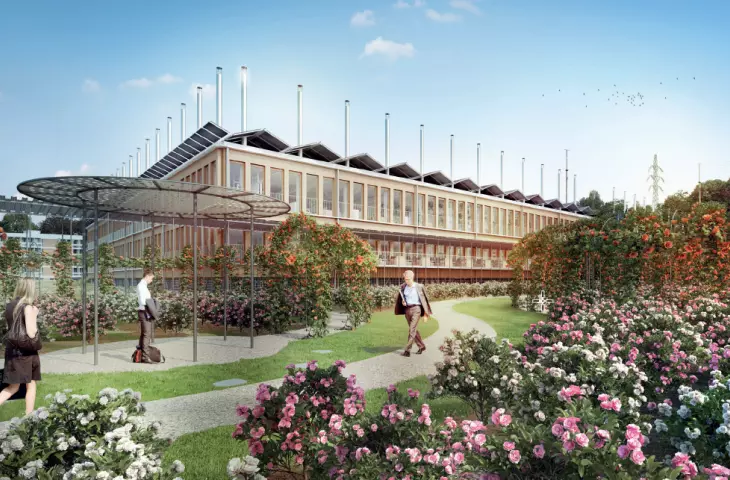Namur Province Administrative Center,
designed by Philippe Samyn and Partners
The design of the New Administrative Center of Namur Province by the studio Philippe Samyn and Partners represents a dynamic intervention in the urban fabric of Salzinnes, designed to become the center of the region's social, cultural and intellectual life. Locating most of the administrative services on the outskirts of the city by the Sambre River, the project boldly transcends the conventional notion of an administrative center, aiming to blend harmoniously with its surroundings, taking into account environmental and cultural assets. Inspired by the idea of locality and the rural heritage of the region, the building catches the eye with a structure reminiscent of a contemporary "village," where greenery, light and natural ventilation are integral elements of the building.
Aerial view of a modern rectangular building with eight courtyards, surrounded by greenery and urban structures
Photo: © Schmitt-GlobalView @ Philippe Samyn and Partners
eco-friendly and classy
The new building has achieved 85% points in the BREEAM certification system, which corresponds to the "Outstanding" level. The project respects the environment and aims to minimize financial and environmental costs.
A modern rectangular building with vertical glass panels reflecting in a nearby pond, surrounded by tall grass
photo: @ Philippe Samyn and Partners
pleasant with useful—an architectural return to nature
The building is located in a bend of the Sambre River, flanked to the northwest by the former Roger Bastin Central Seminary building, and adjacent to the Ecole Saint-Aubain and residential buildings to the southwest. Gardens and cultivated plots are planned for the northeastern part of the 3,300-square-meter site, which draws on the local tradition of urban agriculture.
Aerial view of the modern rectangular building surrounded by greenery and urban structures
photo: @ Philippe Samyn and Partners
A view of the river away from the sound of trains—an administrative slow office?
The edifice is rectangular in form, measuring 106.2 meters by 61.65 meters. Its location was chosen to avoid flood risks and to ensure optimal acoustic conditions, away from the sounds of trains. The building is fully wooden, with two levels, each 3.6 meters high, and rests on steel piles. Photovoltaic panels have been placed on the roof.
Modern building with wooden panels and vertical roof poles
photo: @ Philippe Samyn and Partners
The layout of the premises is based on eight patios measuring 15.3m x 11.25m, which provide natural lighting and ventilation. The building is divided into a variety of functional zones, facilitating free communication and integration of employees, in line with the "New World of Work" concept.
First floor plan with multiple square courtyards
photo: @ Philippe Samyn and Partners
recycled furniture for official elegance
The diversity of the interiors was achieved through the choice of materials, such as fabrics, leathers, wallpapers and artwork. The furniture and finishes were partly made from recycled and reused materials, and sourced locally, in cooperation with the Ressourcerie Namuroise organization.
A spacious interior with large windows, wooden floors, modern furniture and a striped rug
photo: @ Philippe Samyn and Partners
natural ventilation and renewable energy
The building is naturally ventilated, allowing air to circulate without the need for energy-intensive mechanical systems. The ventilation system uses aerators at the patio windows and ventilation chimneys to provide a pleasant indoor microclimate and effective nighttime cooling during the summer.
Modern technologies based on solar energy and heat pumps have been used. Kinetic energy of the river or biomass are not used here due to low energy potential.
Architectural sketch showing the building's natural ventilation with air flow indicated by colored arrows
Photo: @ Philippe Samyn and Partners
accessibility and infrastructure—pleasant with useful
There are 371 parking spaces, including spaces for the disabled, visitors, electric vehicle charging stations and bicycle parking. The space around the building is set aside for recreational gardens, fitness trails and therapeutic gardens.
A modern building with solar panels on the roof, surrounded by greenery and a walkway in the foreground
photo: @ Philippe Samyn and Partners
administration that builds community
The Namur Provincial Administration Center is an example of contemporary architecture that simultaneously cares for the environment and exhibits exceptional spatial qualities. Based on ecological solutions, the project demonstrates how public architecture can harmoniously coexist with the natural landscape, creating a usable space with a strong local identity. With natural ventilation, flexible common spaces and a recycled approach to interior aesthetics, the building integrates elements of tradition and modernity. The orthogonal layout, in the spirit of the urban grids of ancient cities, creates a clear division of functions that promotes communication and collaboration. The "urban village" located here is a haven for sustainable urbanism—from urban gardens to sensory therapy. Philippe Samyn and his team have incorporated into this project a new paradigm of "building the future" that engages both users and the local community, providing space for the development of contemporary forms of work and relaxation.
Elaborated: Natalia Ledzianowska
Illustrations provided courtesy of Philippe Samyn and Partners studio.




















































